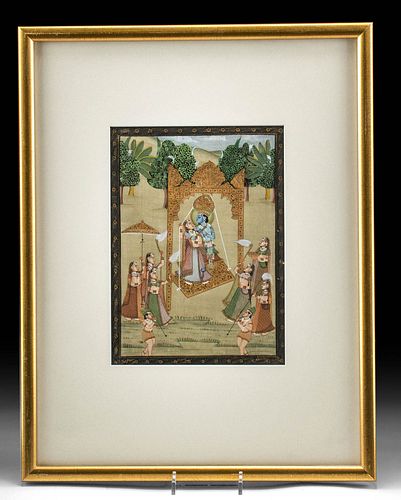Framed Antique Indian Painting - Radha & Krishna
Lot 182
About Seller
Artemis Fine Arts
686 S Taylor Ave, Ste 106
Louisville, CO 80027
United States
Selling antiquities, ancient and ethnographic art online since 1993, Artemis Gallery specializes in Classical Antiquities (Egyptian, Greek, Roman, Near Eastern), Asian, Pre-Columbian, African / Tribal / Oceanographic art. Our extensive inventory includes pottery, stone, metal, wood, glass and textil...Read more
Categories
Estimate:
$400 - $600
Absentee vs Live bid
Two ways to bid:
- Leave a max absentee bid and the platform will bid on your behalf up to your maximum bid during the live auction.
- Bid live during the auction and your bids will be submitted real-time to the auctioneer.
Bid Increments
| Price | Bid Increment |
|---|---|
| $0 | $25 |
| $300 | $50 |
| $1,000 | $100 |
| $2,000 | $250 |
| $5,000 | $500 |
| $10,000 | $1,000 |
| $20,000 | $2,500 |
| $50,000 | $5,000 |
| $100,000 | $10,000 |
| $200,000 | $20,000 |
About Auction
By Artemis Fine Arts
Jun 24, 2021
Set Reminder
2021-06-24 10:00:00
2021-06-24 10:00:00
America/New_York
Bidsquare
Bidsquare : VARIETY SALE | Ancient & Ethnographic Art
https://www.bidsquare.com/auctions/artemis-gallery/variety-sale-ancient-ethnographic-art-7119
Featuring classical antiquities, ancient and ethnographic art. Egyptian, Greek, Roman, Etruscan, Near Eastern, Asian, Pre-Columbian, Native American, African / Tribal, Oceanic, Spanish Colonial, Russian, Fossils, Fine Art, more! All legally acquired, legal to sell. Satisfaction guaranteed. Artemis Fine Arts info@artemisfinearts.com
Featuring classical antiquities, ancient and ethnographic art. Egyptian, Greek, Roman, Etruscan, Near Eastern, Asian, Pre-Columbian, Native American, African / Tribal, Oceanic, Spanish Colonial, Russian, Fossils, Fine Art, more! All legally acquired, legal to sell. Satisfaction guaranteed. Artemis Fine Arts info@artemisfinearts.com
- Lot Description
South Asia, India, ca. 19th century CE. A finely painted depiction of Hindu lovers, most likely the infamous Krishna and Radha. Both are finely dressed, as if in wedding vestments, though the pair never married. Perhaps this is a fantasized vision of their forbidden union - a fictional marriage between the two or the final meeting of the young lovers. A stunning and colorful painting featuring these legendary lovers set in a verdant landscape beneath a golden canopy, and surrounded by attendants. The central image is surrounded by a hand-painted floral border, and the entire composition is matted and framed under glass. The Radha-Krishna romance is a prominent subject of Indian art and literature, serving as a model of allegorical love to which all should aspire. Radha was Krishna's favorite of all the gopis (cow herding maidens), and their love signifying rapture between God and human soul has often been interpreted as the hope for the union between humanity and the divine. Size: 9.375" L x 6.75" W (23.8 cm x 17.1 cm); 18" L x 14" W (45.7 cm x 35.6 cm) framed
This couple had quite a history beginning in childhood when they grew up together, playing, dancing, and hoping to spend the rest of their lives together. Unfortunately the universe pulled them apart. Krishna came to be worshipped as a lord who defended his people and vanquished his enemies, while Radha waited for him. Krishna married Rukmini and Styabhama; he raised a family and fought valiantly in the war of Ayodyha, while Radha still waited - so immense was her love for Krishna. Song writers and poets have used their torrid love as inspiration for centuries.
Why is Krishna's skin blue? This is a question often asked. One legend tells of how the young Krishna was jealous of Radha's light complexion. He asked his mother why nature had been so unfair to him, for he was dark skinned and Radha by comparison possessed a fair complexion. According to one legend, a demon once tried to kill Krishna with poisoned milk and as a result Krishna turned blue. Fortunately, Krishna did not perish; however, the demon disintegrated into ashes. In another story, Krishna's doting mother tried to pacify her son by instructing him to color Radha's face whatever color he wished. He then colored Radha's face so that it looked just like his own.
Mughal painting refers to a type of miniature painting - either serving as book illustrations or created as single work. The term miniature suggests a tiny scale; however, it actually indicates a style of watercolor work similar to early European book illustrations that used the red pigment minia. Some Indian miniatures are in fact quite large. The Mughal style stems from Persian miniature painting, though with Indian Hindu, Jain, and Buddhist influences, evolving largely throughout the Mughal Empire (16th to 19th centuries), and eventually spreading to other Indian courts - Muslim, Hindu, and Sikh - flourishing during the reigns of Akbar, Shah Jahan, and Jahangir. The tradition continues today with Mughal-style miniature paintings still being created, though only by a relatively small number of artists in Rajasthan.
Provenance: ex Gomez collection, Colorado, USA
All items legal to buy/sell under U.S. Statute covering cultural patrimony Code 2600, CHAPTER 14, and are guaranteed to be as described or your money back.
A Certificate of Authenticity will accompany all winning bids.
We ship worldwide and handle all shipping in-house for your convenience.
#145237Painting has not been examined outside the frame but appears to be in very good condition as does the framing. Wired for suspension and ready to hang.Condition
- Shipping Info
-
All shipping is handled in-house for your convenience. Your invoice from Artemis Gallery will include shipping calculation instructions. If in doubt, please inquire BEFORE bidding for estimated shipping costs for individual items.
-
- Buyer's Premium



 EUR
EUR CAD
CAD AUD
AUD GBP
GBP MXN
MXN HKD
HKD CNY
CNY MYR
MYR SEK
SEK SGD
SGD CHF
CHF THB
THB













